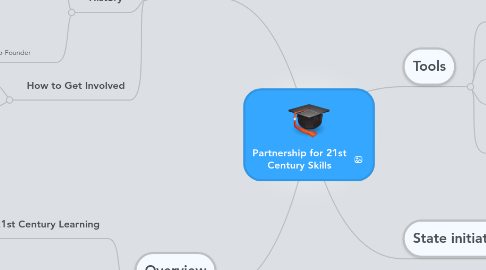
1. About
1.1. P21 Mission Statement
1.1.1. To serve as a catalyst to position 21st century readiness at the center of US K12 education by building collaborative partnerships among education, business, community and government leaders.
1.1.1.1. The 3Rs include: English, reading or language arts; mathematics; science; foreign languages; civics; government; economics; arts; history; and geography.
1.1.1.2. The 4Cs include: Critical thinking & problem solving; Communication, Collaboration; Creativity & innovation.
1.2. History
1.2.1. The Partnership for 21st Century Skills was formed in 2002 through the efforts of the following entities and individuals
1.2.2. U.S. Department of Education AOL Time Warner Foundation Apple Computer, Inc. Cable in the Classroom Cisco Systems, Inc. Dell Computer Corporation Microsoft Corporation National Education Association SAP Ken Kay, President and Co-Founder Diny Golder-Dardis, Special Advisor and Co-Founder
1.3. How to Get Involved
1.3.1. P21 mailing list
1.3.2. Follow us on Twitter
1.3.2.1. @P21CentSkills
2. Overview
2.1. Framework for 21st Century Learning
2.1.1. The Framework presents a holistic view of 21st century teaching and learning that combines a discrete focus on 21st century student outcomes(a blending of specific skills, content knowledge, expertise and literacies) with innovative support systems to help students master the multi-dimensional abilities required of them in the 21st century.
2.1.2. The elements described in this section as “21st centurystudent outcomes” (represented by the rainbow) are the skills, knowledge andexpertise students should master to succeed in work and life in the 21stcentury.
2.1.2.1. 1. Core Subjects and 21st Century Themes
2.1.2.2. 2. Learning and Innovation Skills Creativity and Innovation Critical Thinking and Problem Solving Communication and Collaboration
2.1.2.3. 3. Information, Media and Technology Skills Information Literacy Media Literacy ICT Literacy
2.1.2.4. 4. Life and Career Skills
2.2. Twenty-First Century Support Systems
2.2.1. The elements described below are the critical systemsnecessary to ensure student mastery of 21st century skills. 21st centurystandards, assessments, curriculum, instruction, professional development andlearning environments must be aligned to produce a support system that produces21st century outcomes for today’s students.
2.2.1.1. 1. Twenty-First Century Standards 2. Assessment of 21st Century Skills 3. Twenty-First Century Curriculum and Instruction 4. Twenty-First Century Professional Development 5. Twenty-First Century Learning Environments
3. Tools
3.1. P21’s reports and publications support a vision for learning to ensure 21st century readiness for every student. These documents have been developed through a comprehensive process involving thorough input from partners, educators, researchers, organizations and businesses across the country.
3.2. Educators
3.2.1. RESOURCES FOR EDUCATORS
3.2.2. Implementing 21st Century Skills
3.3. Policymakers
3.3.1. RESOURCES FOR POLICYMAKERS
3.3.2. Implementing 21st Century Skills
3.4. Parents & Communities
3.4.1. RESOURCES FOR PARENTS AND COMMUNITIES
3.4.2. Implementing 21st Century Skills
